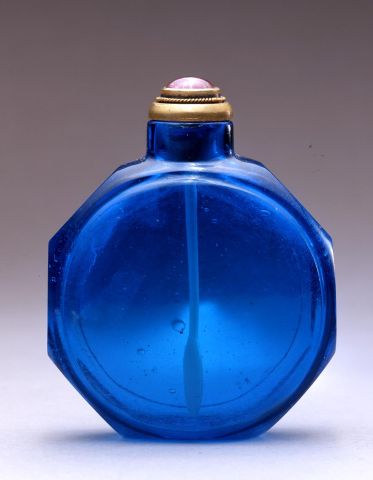
Bottle ID: 00224
BLUE COBALT, OCTAGONAL W/CONVEX PANELS & CRIZZLING
Date: 1790-1874
Height: 59 mm
Glass, of transparent cobalt-blue, of octagonal faceted form, the main fascias with convex circular panels, the side panels of an ovoid form, with a short neck and flat foot, the interior surface with extensive crizzling.
Imperial, attributed to the Palace Workshops, Beijing.
Similar Examples:
Crane Collection nos. 94 and 265.
Xia Gengqi, Zhang Rong. Masterpieces of Snuff Bottles in The Palace Museum, Beijing, 1995, p. 79, no. 54.
Sotheby Parke Bernet (Hong Kong) Ltd., November 2nd, 1978, lot 58, The Arthur Gadsby Collection.
Asian Art Museum of San Francisco, 1995, A Chorus of Colors: Chinese Glass from Three American Collections, p. 122, no. 99.
Provenance:
Hugh Moss [HK] Ltd.
Exhibited:
Annual Convention ICSBS Toronto, October 2007
While this bottle's faceted shape readily identifies it as a product of the glass workshops in the Palace, its larger size and somewhat unique blue tone lends it to a later dating. A similar example in the Palace Museum Collection in Beijing, cited above, has been dated to the Tongzhi period as have the bottles from private collections also cited above. In particular, the bottle from the Gadsby Collection has an incised and gilded four character Tongzhi nianzhi mark. It is extremely unlikely that a Palace mark-writer would put a late mark on a pre-exisiting early bottle, leaving us to conclude that the mark was incised at the time of manufacture. Although this is not absolute proof, the evolution of this form of bottle, in both glass and porcelain, appears to be from smaller and more refined in manufacture to larger and less elegant. The interior of this bottle is very heavily crizzled, a characteristic of eighteenth century glass. However, crizzling occurs as a result of a disproportionate amount of alkali in a batch of glass which could occur during any time period. The Tongzhi period saw a dramatic decline in the production of glass in terms of both quantity and quality and it is as likely that bad "mixes" of glass were made in the later periods of production as in the intial stages. Although it is tempting to place this bottle in the eighteenth century, it would be unrealistic not to allow for a much later date.
< Back to full list
 English
English 中文
中文